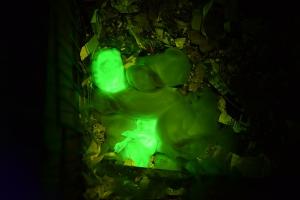International biomedical collaboration produces 'glowing green rabbits'
University of Hawaiʻi at MānoaDirector of Communications, Office of Dean of Medicine
Stefan Moisyadi , (808) 956-3118
Associate Professor, John A. Burns School of Medicine
Using an active transgenesis technique founded by medical researchers at the University of Hawai`i at Mānoa, scientists in Turkey have produced glowing green rabbits. This is the first time the UH technique has been used to produce rabbits.
The transgenic rabbits were born last week at the University of Istanbul. In normal lighting, they look just like their furry, white rabbit siblings. But when exposed to black light, the pair of transgenic bunnies shines a vivid shade of green.
The glowing effect is the result of a fluorescent protein from jellyfish DNA, which was injected into the mother rabbit’s embryo in the lab. The altered embryos were reinserted into the mother rabbit and, when the litter of eight was born, two of the rabbits carried the “glowing gene.” That is a higher percentage rate than previously achieved in rabbits.
The point of the experiment was to show that genetic manipulation with the University of Hawai`i’s technique works efficiently in rabbits. The overall goal is to introduce a beneficial gene into female rabbits, then to collect the protein made in the milk produced by the female rabbits. This approach could lead to new and competitively efficient ways to produce medicines.
The Turkish success was a collaboration between two universities in Turkey and the UH Mānoa Institute for Biogenesis Research (IBR) at the John A. Burns School of Medicine (JABSOM).
The background of project rabbit
University of Hawaiʻi at Mānoa Emeritus Professor Ryuzo Yanagimachi and Associate Professor Stefan Moisyadi travelled to Istanbul in November 2011 to set up the collaboration with the University of Istanbul and Marmara University. Yanagimachi, the founder of the IBR, is recognized around the world as the scientist whose early work with animals laid the foundation for the development of in vitro fertilization in humans. Dr. Yanagimachi also invented a laboratory technique for inserting sperm into an egg, a method that is now used in fertility clinics everywhere. Dr. Yanagimachi produced the world's first cloned mouse and was the first to use his sperm injection technique to produce transgenic mice. To assist with hands-on teaching of the technique, Dr. Moisyadi returned to Istanbul this past June with IBR Transgenic Facility Director Dr. Joel Marh.
Giddy reactions in the rabbits’ new “home town”
All of that laid the groundwork for the new "glowing green rabbits," and the bunnies' birth is being celebrated in the Republic of Turkey. “Our colleagues in Turkey have been so excited by the birth of the transgenic rabbits--and that excitement has spread to the public through news coverage on Turkish television,” said Dr. Moisyadi. “It’s been wonderful to see this international scientific collaboration produce such positive results.” Dr. Moisyadi is a native of Turkey who began his graduate work at UH Mānoa in 1984 and, as a scientist, he is following in Dr. Yanagimachiʻs footsteps.
What’s Next?
The Turkey-Hawai`i team also has worked on producing transgenic sheep. Three months from now, in November 2013, the birth of Turkey’s first transgenic lamb is expected. The IBR team has already collaborated with China to produce transgenic pigs.
The Institute for Biogenesis Research at JABSOM is the home of high-level reproductive research. It is located within the medical school's department of Anatomy, Biochemistry and Physiology. Its goals include continuing to improve human in vitro fertilization techniques. Its Director is Dr. W. Steven Ward.
RESOURCES:
Link to Vimeo video (silent; shows Turkish University, rabbits in regular and black light, Turkish scientist speaking at: https://vimeo.com/71936493
A link to the UHMed Flickr photo stream at: http://www.flickr.com/photos/uhmed/sets/72157634990121276/
For more information, visit: http://jabsom.hawaii.edu

